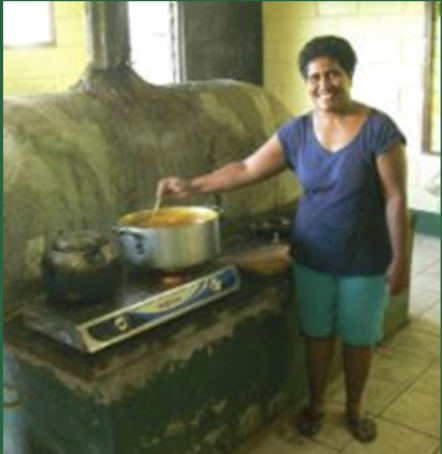Frying
“I see breadfruit chips in the shops – are they easy to produce?”
Frying slices of breadfruit is another method by which moisture can be removed. Soybean or palm kernel oils are usually heated to approximately 150oC to 180oC. This temperature is above the temperature at which water boils so that the water boils off as the breadfruit slices sizzle. The breadfruit must be sliced thinly in order to remove sufficient water for the breadfruit to keep. Further, the chips should be cut as evenly as possible to avoid overcooking the thinner ones and leaving too much moisture in the thicker ones. A range of simple hand slicers are available to ensure slice consistency. High quality Swedish Hällde slicers are ideal for Pacific Islands’ enterprises.
As the frying continues, the water is progressively removed and the sizzling stops and the slices become crisp. After frying the excess oil is removed by shaking and the chips are allowed to cool down.
The oil temperature needs to be high as the slices are removed from the oil. At high temperature, the oil is mobile and drains from the slices easily. At low temperature, the oil sticks to the slices which will increase costs. Fried snack foods with high oil contents are more prone to rancidity during storage, they are nutritionally less desirable and the mouth-feel is poor.
Oils used for cooking must be heated to temperatures a little below the smoke point and relatively small quantities of slices added to it, to prevent excessive cooling. Old oil should not be added to new oil but all used oil can be pooled and washed with water. The oil layer can be poured off the sludge that settles at the bottom of the container and re-used.
Packaging materials must be moisture-proof. The choice of packaging depends on the expected shelf life. If the breadfruit chips are to be sold locally then 50 micron polypropylene will give a shelf life of one month at tropical temperatures. If longer shelf life is required then more complicated, and therefore more expensive, composite packaging is required (see processing manual).
Breadfruit chips have universal appeal and are found not only in supermarkets but in small communities and school shops. The equipment and materials needed in the village to manufacture breadfruit chips include a suitable pot for frying, a hand slicer and oil for frying. Chips are an ideal scale product for a cottage industry scale processing enterprise (Fig. 13) given the relatively small initial capital investment required.



Figure 13: Cottage industry breadfruit chip manufactures in Samoa and Fiji
|
Key points to remember:
|
